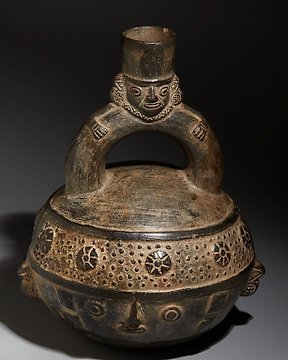
Chimú, Perú. Terracotta Huaco. 100-1200 AD. 22.5 cm Height. Spanish Export License.
No. 83804353

No. 83804353

Vessel with the effigy of a feline.
CULTURE: Vicús, Perú.
PERIOD: 200-800 AD.
MATERIAL: Terracotta
DIMENSIONS: Height 22.7 cm
CONDITION: In good condition.
PROVENANCE:
-Private collection of Jean Pierre Cottier and Fiorella Cottier-Angeli, Geneva, Switzerland. Acquired between 1960 and 1980 from, among others, Carlos Campilli (Miami, United States of America), Sophie Pdgorska (Geneva, Switzerland) and Marguerite Motte (Paris, France).
-Yossef Maiman private collection. Acquired between 2000 and 2008.
DOCUMENTATION: Spanish Import license included.
DESCRIPTION:
Vicús culture was an important early culture in Peru from 1000-200 BC to 300-600 AD. They lived in the Piura region in the northern Pacific coast of Peru. Its administrative headquarters, located in the "Cerro Vicús", at an altitude of 170 meters above sea level, and which gives its name to this culture, served as a link with other Andean cities located further north.
The most important feature of this culture is agriculture, the basis for their economic development. It is known that they cultivated squash or mate, corn and some fruits, with advanced irrigation systems. These activities were complemented by livestock or hunting. The vicus, connoisseurs of the alloys of silver, gold and copper, even used these metals in the elaboration of their farming instruments.
It is known that Vicús was an eminently patriarchal society, where the men were the only ones who could wear jewelry and elegant clothing, while the women of the nobility could only wear very simple suits. The main instrument of control and social exploitation, backed by fierce militarism, was a strong contingent of noble warriors that scoured the domain to enforce the sovereign's mandates.
They were known for their work in ceramics, copper, and gold. Living mainly on the coastal deserts, they used the native clay and local dyes to produce natural and religious symbols; modern day pottery from the town of Chulucanas is said to closely resemble the ancient art. They created Double spout and bridge vessel that created whistling sounds when pouring liquids.
Notes:
The seller guarantees that he acquired this piece according to all national and international laws related to the ownership of cultural property. Provenance statement seen by Catawiki.
The seller will take care that any necessary permits, like an export license will be arranged, he will inform the buyer about the status of it if this takes more than a few days.
The piece includes authenticity certificate.
The piece includes Spanish Export License.
How to buy on Catawiki
1. Discover something special
2. Place the top bid
3. Make a secure payment